Embark with me as we explore how to make the most of a single day in the captivating city of Augsburg. This article is your personal guide to experiencing the heart of Bavaria, from centuries-old historic sites to delightful culinary spots that capture the essence of local life.
Augsburg isn’t just another dot on the map; it’s a mosaic of history, culture, and vivid daily rhythms waiting to be discovered. It’s one of the oldest cities in Germany and a must for any history lover.
I’ll walk you through the cobbled streets, under the shadow of majestic structures, and through the serene landscapes that have been shaped by emperors, bankers, and artists alike. The city’s rich past intertwines with its vibrant present, offering an array of experiences that blend seamlessly into a day’s adventure.
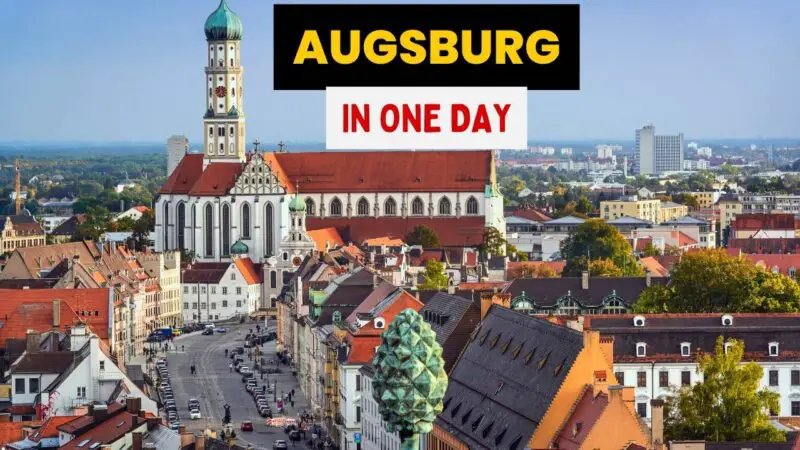
In Augsburg, where history echoes through high arches and modern life buzzes in bustling plazas, every moment counts. So, let’s dive into what this magnificent city offers, ensuring that when the evening draws in, you’ll be brimming with stories to tell of your day spent within the embrace of Augsburg’s enduring charm.
Whether you’re a history enthusiast, a lover of art, or simply in search of a day well-spent, join me as we uncover the best that a day in Augsburg has to offer.
Love Germany? Click here to download your free guide to 25 Incredible Things You Must Do In Germany In Your Lifetime. You won’t want to miss them!
A Brief History Of Augsburg
Augsburg, located in the southwest of Bavaria, Germany, is a city steeped in a rich tapestry of history that dates back to the Roman Empire. Founded by the Romans in 15 BC as Augusta Vindelicorum, named after the Roman Emperor Augustus, it quickly became a thriving provincial capital due to its strategic position at the convergence of major trade routes.
This early period cemented Augsburg’s role as a significant center of commerce and set the stage for its future prosperity.
In the early Middle Ages, Augsburg was a witness to the rise of Christianity and became an important bishopric, which elevated its status further. The city’s importance burgeoned in the late Middle Ages when it became a free imperial city in 1276.
This newfound status granted Augsburg a level of autonomy that allowed it to flourish. The city became a hotspot for bankers, merchants, and craftsmen who attracted trade from across Europe.

The 15th and 16th centuries marked Augsburg’s peak as a financial powerhouse; known for the Fugger and Welser banking families. Jakob Fugger, “the Rich,” attained great influence not only across Europe but also within Augsburg, notably founding the Fuggerei, the world’s oldest social housing complex that still operates today.
It was during this period that the Augsburg Confession, a central document of Lutheranism, was presented at the Diet of Augsburg in 1530, underscoring the city’s pivotal role amid the tumultuous religious upheaval of the Reformation era.
By the time of the Renaissance and the early modern era, Augsburg’s influence as a center for finance began to wane due to the Thirty Years’ War and the shifting powers of European states, yet it remained a beacon for the arts and culture. The beauty of its architecture, including its Renaissance town hall and the Schaezlerpalais, attest to its enduring importance.
During the Industrial Revolution, Augsburg adapted and evolved, becoming an industrial hub with a particular emphasis on textiles and machinery. This period saw economic recovery and technological progress. Augsburg’s ties to innovation continued through the 20th century, with it being a key location for notable companies, including MAN SE and KUKA Robotics.
Despite the destruction that came with World War II, much of Augsburg’s historical character has been preserved or restored, which speaks volumes about the value placed on its heritage. Present-day Augsburg is a testament to endurance, continually building upon its past while looking toward a future of innovation and growth.
Recognized for its historical significance, Augsburg was named a UNESCO World Heritage site in 2019, celebrating its water management system that spans over centuries.
Augsburg thus encapsulates the essence of a city that has not only survived through the ages but has also thrived, adapting to each new era while maintaining a profound connection to its illustrious history.
What To See In Augsburg In One Day
One day in Augsburg is not enough to experience everything, but it is enough time to get a nice introduction to the city. Simply follow the below Augsburg itinerary stop-by-stop for an incredible day.
It’s been designed to be completed by foot and public transport. In fact, you can easily walk between the stops except the Botanical Gardens which is a little further. You could walk or you can easily take a bus to and from here.
Click here to find all these attractions plotted in Google Maps so you can see how to get between places.
Stop 1: Fuggerei
Visit the world’s oldest social housing complex
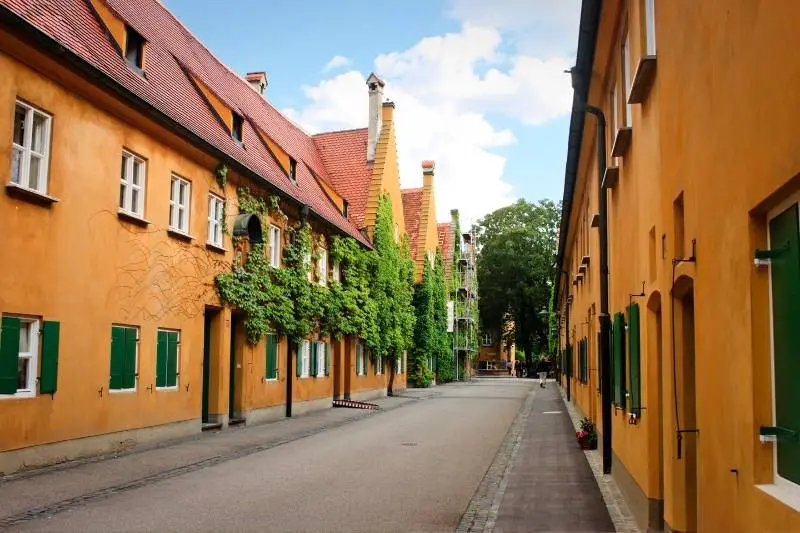
A step into the Fuggerei is a step back in time, a glimpse into a living piece of history. Founded in 1521 by the wealthy merchant Jakob Fugger, the complex was built as a charitable settlement for the city’s destitute, and it continues to serve that noble purpose to this day.
The Fuggerei’s significance goes beyond Augsburg, as it stands as a symbol of social welfare long before the concept was widely recognized. The annual rent has famously remained unchanged for centuries—equivalent to just one Rheinischer Gulden, or about 0.88 euros—illustrating the enduring legacy of the Fugger family’s philanthropy.
Visitors are invited to experience the modest living conditions within these walls, and to learn about the history and lives of its residents through a small museum inside the complex. You can see how residents used to live in this museum and also view a modern apartment elsewhere in the settlement.
The picturesque rows of houses, with their meticulous gardens and the original rules still in place, make this site not only unique to Augsburg but to the world.
Stop 2: Augsburg Cathedral
Admire the stunning architecture and stained glass windows
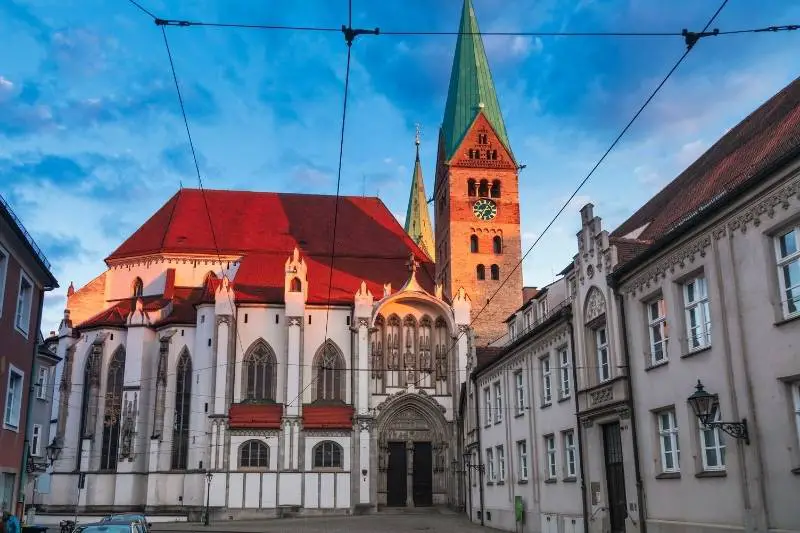
Rising majestically over Augsburg, the cathedral is a masterpiece of architectural evolution, reflecting styles from Romanesque to Gothic. Its oldest parts date back to the 11th century, and the building has grown and changed with the city itself.
The cathedral’s famed stained glass windows, some of the oldest in existence, cast ethereal light upon centuries of religious art and craftsmanship. Guests can marvel at the Prophet Windows, dating back to around 1140, and reflect on the human desire to express devotion through beauty.
The cathedral houses numerous pieces of significant artwork, including the altar by Hans Holbein the Elder. It is a testament not only to Augsburg’s religious importance but also to its role as a center for artistic innovation through the ages.
Stop 3: Maximilianmuseum
Explore art and history at Augsburg’s premier museum
The Maximilianmuseum is a treasure trove of Augsburg’s rich heritage, displayed within the walls of two interconnected Renaissance buildings.
The museum’s extensive collection is dedicated to the city’s history of art and craftsmanship, especially during the Renaissance period when Augsburg’s artisans gained fame across Europe. Here, visitors come face to face with intricate examples of Augsburg silverwork, exquisite goldsmithery, and the renowned “Augsburg Cabinets,” which are marvels of both art and utility.
The museum’s exhibits facilitate a deep understanding of the city’s historical significance as an artistic and trade hub. The carefully restored interiors of the museum buildings themselves are as much a part of the exhibit as the artifacts they hold.
Stop 4: Lunch at the Rathausplatz
Experience local cuisine in the historic town square
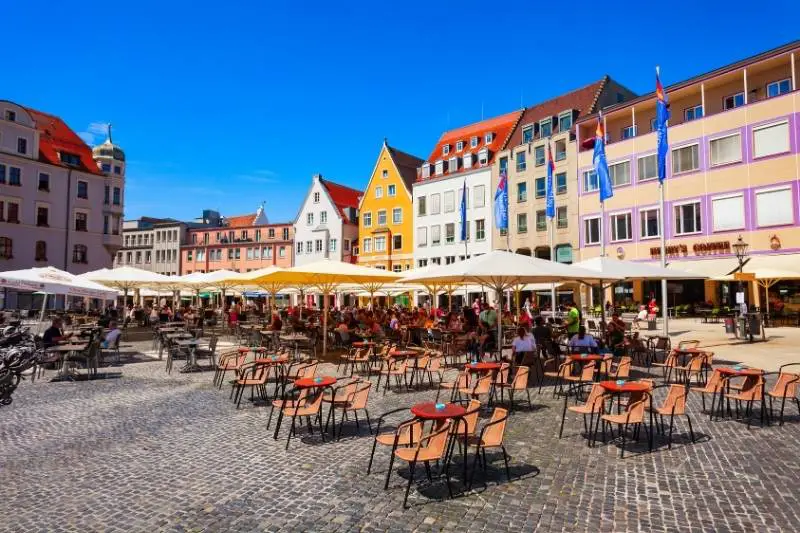
The Rathausplatz is the vibrant core of Augsburg’s old town, bordered by the imposing Town Hall and the Perlachturm (tower). This area is not just a picturesque spot to grab lunch; it’s an open-air banquet of historical sights. Eating here is about more than delightful local cuisine—it’s about participating in a tradition of public life and commerce that stretches back to the city’s foundation.
Eateries surrounding the plaza serve the best of Bavarian fare, with dishes that have satisfied the appetites of residents and travelers alike for generations. Whether it’s for a hearty plate of Käsespätzle, a flavorful bratwurst, or a crisp pretzel, dining at Rathausplatz offers an authentic ambiance where every bite is a taste of Augsburg’s storied past and present.
If you need to work up an appetite, or need to work off your food afterwards, climb the Perlachturm before or after eating. You won’t be able to miss it.
Stop 5: Augsburg Town Hall and the Golden Hall
Witness the splendor of Renaissance architecture
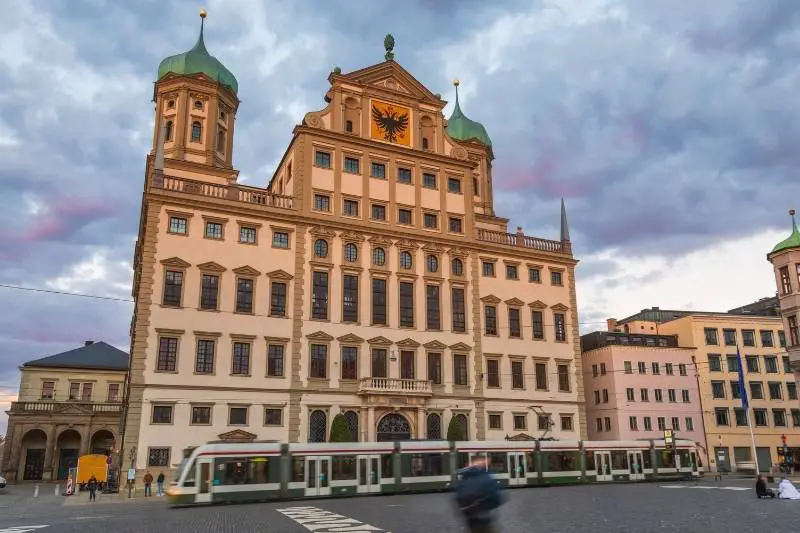
The Augsburg Town Hall, constructed in the 1600s, is a monumental expression of the city’s economic power and civic pride during the Renaissance. Under the masterful direction of architect Elias Holl, it emerged as a crown jewel of civic architecture.
The Golden Hall (Goldener Saal), known for its breathtaking ceiling and walls covered in real gold leaf, demonstrates the wealth and artistic ambition that characterized Augsburg’s golden period. You can pay to enter this.
As the political heart of the city for many centuries, the Town Hall has witnessed crucial decisions and historic events. The building’s sheer presence and opulence make it an indispensable stop for comprehending the depth of Augsburg’s historical importance, and its majesty renders it a source of awe for all who enter its halls.
Also, don’t miss the Augustusbrunnen fountain out the front honoring the Roman Emperor this city was initially named after.
Stop 6: Schaezlerpalais
Explore baroque art and architecture
The Schaezlerpalais is a masterclass in baroque magnificence. Erected in 1765 by architect Karl Albert von Lespilliez, it encapsulates the essence of Augsburg’s baroque period, serving as both a palatial residence and a cultural center.
Now a museum, guests are invited to promenade through the palatial rooms adorned with period furnishings, frescoes, and a notable art collection. The gallery’s highlight is the Grand Ballroom, a stunning example of baroque opulence designed to reflect status and sophistication.
This palace affords visitors the opportunity not only to admire but also to feel enveloped by the lavish lifestyle of Augsburg’s 18th-century elite. It’s a stunning palace and worth the entry charge.
Stop 7: Augsburg Botanical Garden
Relax in nature’s embrace
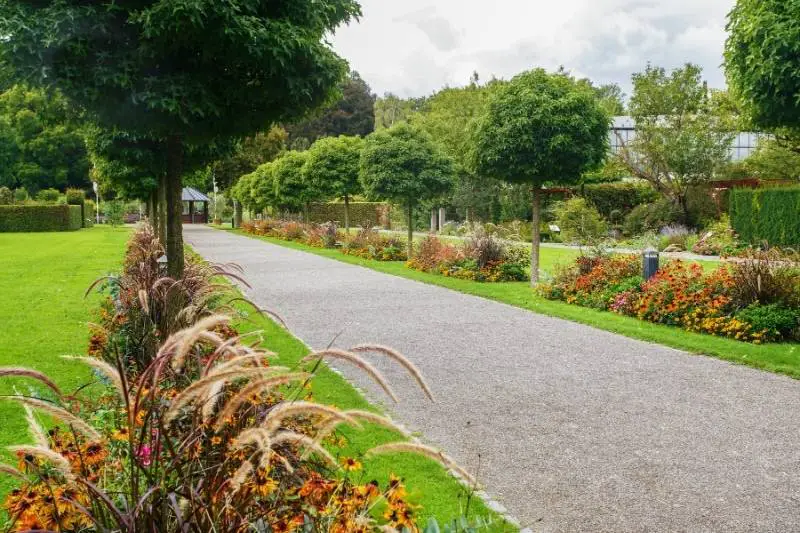
The Augsburg Botanical Garden offers a departure from the city’s historical ambiance into the realm of natural beauty.
Spread over 10 hectares, the garden boasts diverse collections from alpine to exotic and enchanting themed areas such as the Japanese Garden. It is a sanctuary that elevates gardening to an art form, carefully designed to offer a retreat for the senses and a learning experience for the curious.
The seasonal transformations grant repeat visitors a new experience with each visit. In the luscious greenery and blooming flowers, one finds a peaceful balance to the city’s architectural grandeur.
Have a wander and a rest as it’s been a busy day.
Stop 8: Dinner at Maximilianstraße
Indulge in Bavarian hospitality
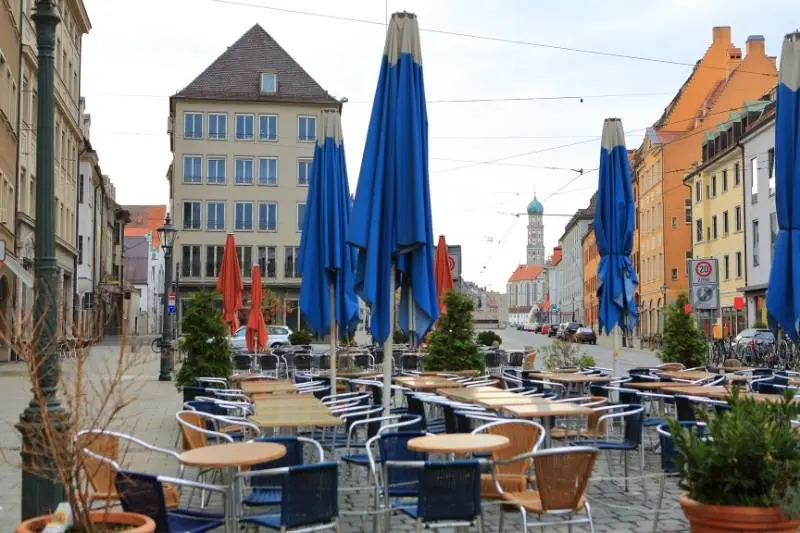
As night falls, Maximilianstraße assumes its role as Augsburg’s epicurean axis. Lined with restaurants and cafes, it provides a diverse culinary landscape set among historic facades and modern boutiques.
The street offers dining experiences ranging from traditional Bavarian pubs to contemporary international cuisine, satisfying both the gastronomic adventurer and the lover of hearty local dishes. Ending the day here isn’t just about experiencing standard fare; it’s a celebration of the city’s prosperous trade roots that brought an array of world flavors to Augsburg.
How To Get To Augsburg
Embarking on a journey to Augsburg, the enchanting city in Bavaria, is an experience laced with both ease and comfort. Whether you’re navigating from the bustling streets of Berlin or the tranquil shores of Lake Constance, your path to Augsburg is well-paved and straightforward.
If you’re soaring through the skies to Augsburg, the nearest major airport is Munich Airport. From there, trains can take you to Augsburg’s central station in about one and a half hours. Watch the Bavarian countryside unfurl outside your window, a gentle prelude to the historical delights that await.
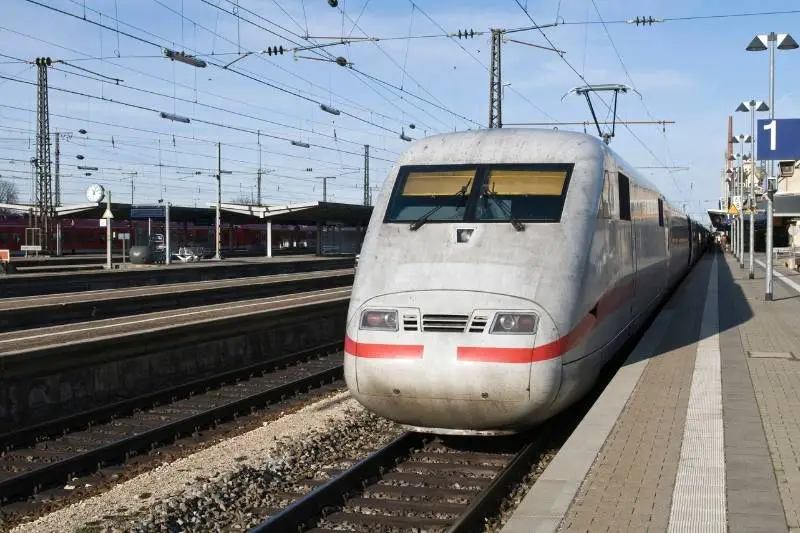
Perhaps you’re setting out from another German city by train. Deutsche Bahn, the national railway company, offers frequent and reliable services to Augsburg from major cities like Berlin, Hamburg, or Frankfurt. The high-speed ICE trains can whisk you to Augsburg in a matter of hours, with amenities that ensure a smooth ride. From Munich, it’s just a 30 minute trip making an Augsburg day trip very easy.
Click here to check out Deutsche Bahn schedules and prices.
Traveling by car is no less convenient. Augsburg is well-connected to the German autobahn network. You’ll find it nestled near the A8, which runs directly from Stuttgart to Munich. Rent a car or hop into yours and navigate the well-signed routes. You’ll appreciate the autonomy of rest stops and scenic detours at your leisure.
Click here to check out car hire options and prices.
Final Words
Spending a single day in the captivating city of Augsburg will leave you enchanted by its fusion of historical grandeur and vibrant culture. From traversing its cobblestone streets to immersing yourself in its rich tapestry of arts, each moment in Augsburg is an opportunity to connect with a past that vividly dances alongside the present.
Read our guides to nearby Munich here, Ulm here, Nördlingen here and Dinkelsbühl here. Find all our guides to Southern Germany here.
